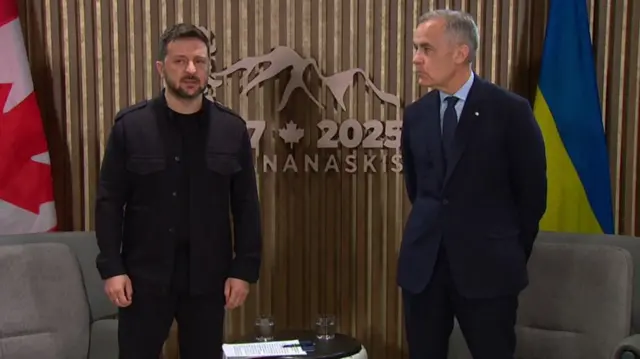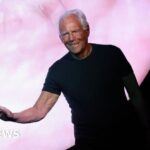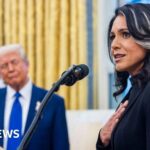We’ve just heard from Canadian Prime Minister Mark Carney and Ukrainian President Volodymyr Zelensky, who are meeting at the G7 summit in Canada.
Carney says support for Ukraine will be “unwavering” – we’ll have more quotes from both leaders soon.
Trump’s early departure from the summit ruled headlines this morning, but agreements were still struck on key issues despite the US president’s early departure.
Here’s what happened:
- The US and the UK reached a deal on tariffs, and Trump says that the UK is “very well protected” from future levies
- Trump said that Russia’s removal from the economic bloc was a mistake, but added there’s “too much water over the dam” for the nation to return
- We learned that a deal between Canada and the US on trade might be struck within a month following a meeting at the summit between Canada’s PM Mark Carney and Trump
- Delegates released a statement calling for peace in the Middle East – with all leaders signing on, following earlier reports Trump would refuse to sign
- Leaders posed for the annual family photo with a Rocky Mountain backdrop
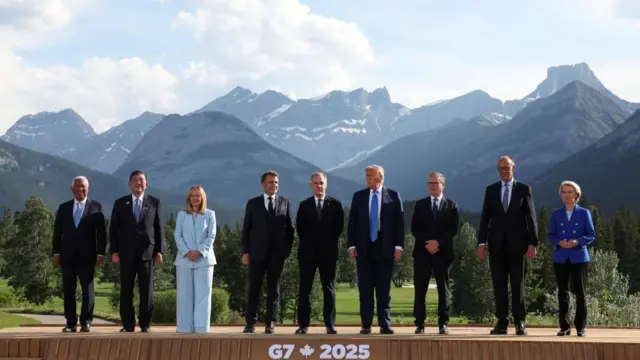

Chief North America correspondent, reporting from the G7
Here at the G7 – which for today has become the G6 – it feels a bit like a wedding without the bride.
The United States is the biggest, most powerful country in the world. It has historically been the leader of the G7, so Donald Trump’s abrupt departure is a test of the summit’s relevance.
The Canadian hosts say there has still been progress and that a lot of good work has been done, including a joint statement on the Middle East which the Americans signed after it was watered down – but they sort of have to say that.
It’s true, there was no falling out, which I think the Canadians will see as a huge achievement.
But there’s a whole raft of other world leaders turning up today – Volodymyr Zelensky, Narendra Modi, Anthony Albanese – all expecting to have face time with the US president. They will try to make the best of it, but they have been left at the altar.
There will be lots more warm words, the rest of the G7 will work with the visiting heads of state to hammer out some statements. In truth, though, the real work here has been the bilateral discussions on issues such as trade, rather than what the group as a whole can say about the state of the world.
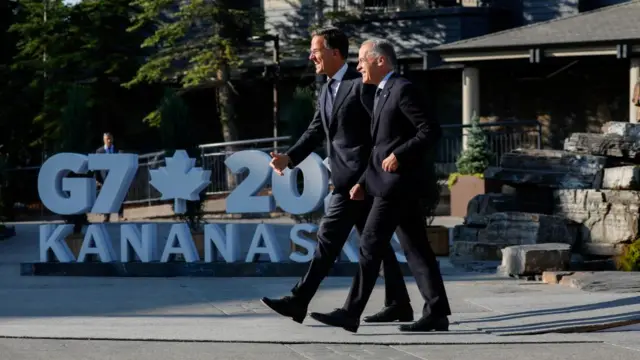
The G7 summit in Alberta, Canada will congregate for a third day today – with the notable exception of US President Donald Trump.
The US president left the economic bloc’s summit ahead of schedule last night, with the White House confirming he had to see to affairs at home as Israel’s strikes on Iran continue.
But diplomatic talks will continue regardless of the US president’s absence.
The Iran-Israel conflict will likely lead discussions – but there’s more on the table, as leaders discuss trade, security and the war in Ukraine.
We’ll be following key developments from the summit right here. Stay with us.
G7 leaders have been hoping to get Donald Trump’s full attention to discuss issues like global trade and the Russian war of aggression against Ukraine.
Instead, the US president is now due to return to Washington a day early, given the worsening conflict between Iran and Israel.
The White House insists that Trump has achieved much during the trip – most prominently signing a tariff deal with UK Prime Minister Sir Keir Starmer.
Even with Trump leaving early, the show must go on for Canada’s PM Mark Carney, who will be hosting the leaders from France, Germany, Italy, Japan alongside guests from India, Australia and Brazil.
We’ll shortly be closing our live coverage. You can stay up to date on the latest developments on the BBC website.

BBC News, Sydney
The Australian PM’s primary goal this summit was a meeting with Donald Trump – something Anthony Albanese has been desperately trying to arrange since he was re-elected last month.
The pair have a lot to discuss. Albanese wants to negotiate exemptions to the White House’s sweeping tariffs scheme, and he also wants to bend Trump’s ear on the Aukus defence pact, which the administration announced it was reviewing last week.
But just as Albanese was outlining his agenda for the upcoming meeting at a press conference, it was announced Trump would be cutting his trip to Canada short – and tomorrow’s Albanese meeting from his diary.
A spokesperson for the prime minister in a statement said it was “understandable” given what is occurring in Israel and Iran.
“As the Prime Minister said a short time ago, we are very concerned
about the events in the Middle East and continue to urge all parties to
prioritise dialogue and diplomacy.”

French President Emmanuel Macron was speaking to reporters just as news came that President Trump was leaving early to handle the unfolding crisis in the Middle East.
Trump, according to Macron, said “moments ago” that talks were underway.
“If the United States can get a ceasefire, that’s a very good thing,” he said. “France would support it.”
Asked how Macron read Trump’s early exit, the French leader said there were US offers on a ceasefire that could lead to wider talks.
“I think that’s a good thing.”
Trump is leaving the G7 in Canada a day early – and it’s not without precedent.
At the 2018 summit, coincidentally also hosted in Canada, Trump left the gathering of world leaders to meet with North Korea’s leader Kim Jong Un.
He left the Charlevoix, Quebec conference and flew to Singapore where he met Kim for talks about North Korea’s nuclear programme.
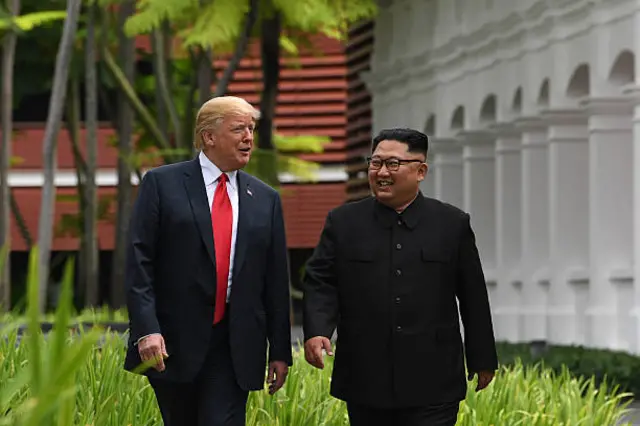
Just like seven years ago, he leaves early because of conflicts surrounding another country’s nuclear programme – this time Iran’s.
As a reminder, Israel has launched air strikes on Iranian cities citing its concern that Iran’s nuclear programme threatens Israel. Tehran has retaliated with airstrikes of its own, some of which have penetrated Israeli air defence systems.
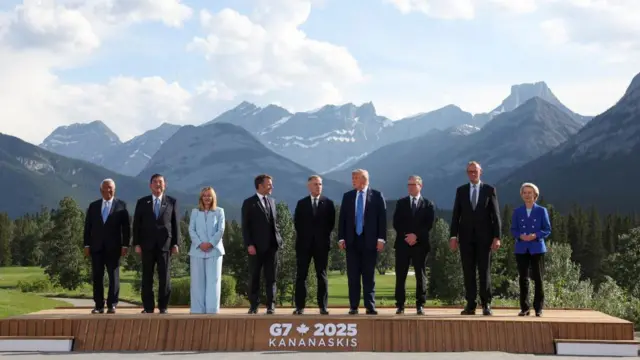
We have just seen the leaders posing for the “family photo”.
They stood on a platform with an imposing mountain range behind them.
After the photo, as some leaders were already leaving the stage, Trump started taking reporter’s questions about his early exit: “I have to be back as soon as I can.” He was referring to the Middle East crisis.
He added: “I think we got a lot done,” gesturing to the UK Prime Minister Sir Keir Starmer, with whom he signed a tariff deal.
The host, Canada’s PM Mark Carney, said he “fully understands why” Trump is leaving a day early.

North America correspondent, reporting from the G7
Donald Trump’s visit to Canada and the G7 summit turns out to be
a short one.
While those of us in his press pool were holding in vans, awaiting
the short drive with the motorcade to the leaders’ “family photo” and dinner at
a nearby resort golf course, we were informed of the change of plans: The president would be heading back to Washington tonight.
A few
minutes later, in a post on X, White House Press Secretary Karoline Leavitt told us that it
was because of “what’s going on in the Middle East”.
The president is sticking around for dinner, so that means he will
be travelling practically across the North American continent overnight.
It has already been an eventful day here in Kananaskis. We’ve had
multiple chances to interact with the president, and he has been adamant that
Iran’s nuclear programme must be fully dismantled – and that the nation is not
winning its war against Israel.
According to Fox News, he has told his National
Security Council to be ready to meet. He will have all the secure
communications he needs aboard Air Force One.

Live reporter
We are eagerly awaiting the “family photo” where all the leaders gather for a group snap.
It is staged and often behind an imposing background as the leaders all smile.
They can be historic: last year when Italy hosted the summit, the late Pope Francis joined the dignitaries for the group photo, becoming the first pontiff to do so.

But in 2018, it was not the family photo that captured headlines. It was a side photo of leaders in discussion that captured the awkwardness and tension at the summit in Charlevoix, Quebec.
Trump, during his first term (just as he is doing now) was pursuing an aggressive international trade policy strategy even with allies like Canada and the EU.
The photo shows a seated Trump, with arms crossed, surrounded by colleagues included Germany’s Angela Merkel, France’s Macron, and a visibly bored Shinzo Abe of Japan.
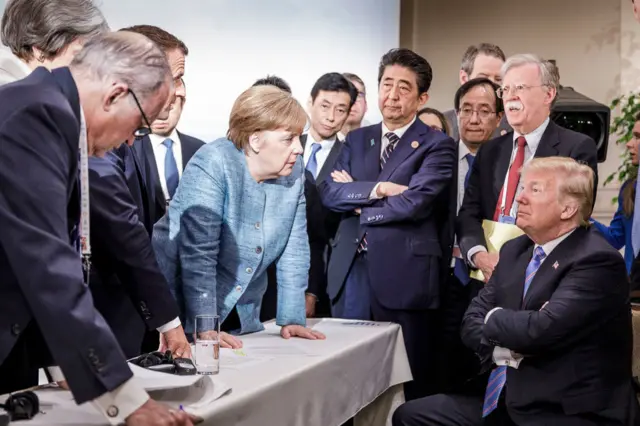
It is a first G7 for several of the leaders today so we will be looking out for the same details, from subtle body language cues down to how order in which these powerful men and women line up.
You can watch the family photo moment live, due to be delivered shortly, by clicking the green button above.
While Trump departs to Washington, the G7 will roll on without him.
There are a couple of key things he will likely miss a couple of planned bilateral meetings, including with Ukrainian President Volodymyr Zelensky.
Ukraine is on the agenda tomorrow, and is expected to be pushing for more sanctions on Russia, for which Trump has expressed skepticism.
He was also expected to sit down with Mexican President Claudia Sheinbaum.
A number of other world leaders – who are invited as guests of G7 host Mark Carney – are only arriving tonight, just as Trump makes his way home. They include Indian Prime Minister Narendra Modi and Brazilian President Luiz Inácio Lula da Silva.
The White House says the US president is bowing out early from this G7 due to the conflict in the Middle East.
Certainly, much of the discussion here – on global security and trade – has been overshadowed by the deteriorating situation between Israel and Iran.
It’s clear there were some rifts over a joint communique being fleshed out by the leaders and their aides – and whether there was consensus around a call for de-escalation.
Trump will stay for the traditional family photo and for a dinner, before heading back to Washington tonight.
It seems like Trump is bowing out a day early of this G7, after dinner with the fellow leaders.
“President Trump will return to Washington tonight so he can attend to many important matters,” White House spokeswoman Karoline Leavitt said on X.

Reporting from the G7
We’re getting a little more detail on this morning’s meeting between President Donald Trump and Prime Minister Mark Carney.
According to a readout of the meeting released by Carney’s office, the “leaders agreed to pursue negotiations toward a deal within the coming 30 days”.
As a reminder, earlier today the pair said there had been movement on talks between the countries despite – in Trump’s words – the two men having “different concepts” on trade.
Trump’s tariffs on the UK aerospace sector are set to be removed entirely as part of today’s trade deal.
This is a win for companies like Rolls-Royce, the luxury car maker that is also a major manufacturer of aircraft engines.
All other countries face a baseline tariff of 10% on aerospace goods, including aircraft parts.

Live reporter
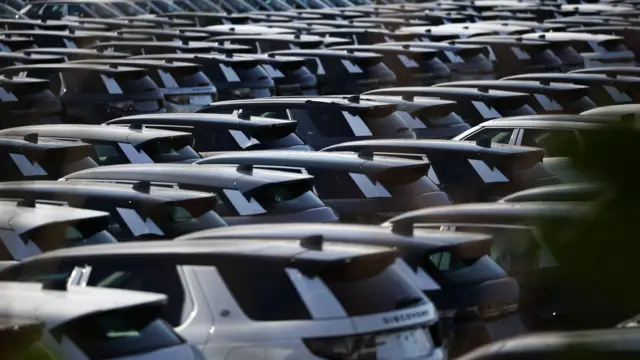
British cars like the popular Range Rover SUVs will no longer face a 25% levy in the US. The UK is the only country to have secured this kind of agreement with the US – but there’s a catch.
The agreement presented by Starmer and Trump today establishes that 100,000 British automobiles can come into the US with a 10% tariff rate. Anything beyond that is subject to a 25% rate.
In a 12-month period up to the end of the third quarter of 2024, UK vehicle imports to the US were worth more than $12.2bn (£9bn), according to the UK trade department.
UK automaker Jaguar Land Rover exports almost a quarter of its cars to the US, and had previously said the deal would secure “greater certainty for our sector”.
For car parts, the agreement is slightly different. Parts made in the UK that are for use in UK cars will also have tariffs go down from 25% to 10%, but in that instance, there’s no quota.
British Business and Trade Secretary Jonathan Reynolds said this deal protects UK workers and businesses.
“We agreed this deal with the US to ensure jobs and livelihoods in some of our most vital sectors were protected, and since then we have been focused on delivering those benefits to businesses,” he said.
Tariffs are taxes charged on goods bought from other countries.
Typically, they are a percentage of a product’s value.
A 10% tariff means a $10 product would have a $1 tax on top – taking the total cost to $11 (£8.35).
Companies that bring foreign goods into the US have to pay the tax to the government.
They may pass some or all of the extra cost on to customers. Firms may also decide to import fewer goods.
Since beginning his second term, Trump has implemented sweeping tariffs on imports to the US, leading to retaliatory actions from others including China and Canada.
- Read more: What tariffs has Trump announced?

The unveiling of a signed tariff deal between the US and UK was not without some hiccups.
As US President Donald Trump opened the document to show the media, several pages spilled out on to the ground.
Trump then referred to the document as a “trade agreement with the European Union”.
Starmer later clarified it was a deal between the US and the UK, saying it was “a good day for both our countries, a real sign of strength”.

New York business reporter
President Donald Trump has signed documents to reduce tariffs on UK cars being imported to the US, which will bring into force parts of a tariff pact agreed between the two countries last month.
Speaking at the G7 summit in Canada, Prime Minister Sir Keir Starmer called the move a “very important day” for both countries.
The pact was the first that the White House has announced since it imposed tariffs on various goods entering America from around the world earlier this year.
But a 10% levy remains in place on most goods, including cars, arriving to American shores from the UK.
